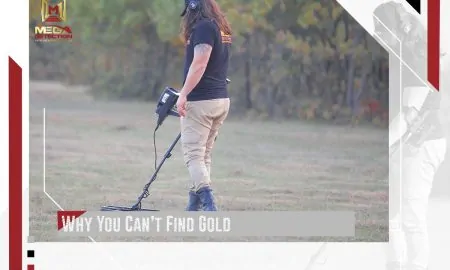Gold Detecting Tips 2023
Gold Detecting Tips , There are few other hobbies where you can have fun outdoors and potentially make money at the same time. The interest in gold prospecting is as strong now as it has ever been, but it’s definitely getting harder to find the yellow stuff these days. With the right knowledge and skills there is no doubt that plenty is left for you to find.
Use good maps with land ownership
You need to understand how to read a map and how to determine who owns a piece of land before you go prospecting on it. If land is private then you will need to obtain permission. If it’s public land, you need to make sure that it hasn’t been claimed by someone already.
The easiest way to determine land ownership is to get a map from the BLM or Forest Service for your area. These maps will include the land ownership, letting you tell the difference between private and public lands.
Thes maps will lack some detail that you need, but they are good for general navigation. Finding access roads into old mines will be worth the purchase alone.
The detailed 1:24,000 scale maps are the best ones, and will show the best detail, sometimes even including mines and prospects. However, it is the 1:100,000 scale maps that will usually show land ownership information.
Get Permission from claim holders
Unfortunately, many of the richest gold-bearing areas today are all claimed up. In some rich gold mining districts, it can be very challenging to find an area to prospect that has good gold.
One way to gain access is to find out who owns the claim to an area, and simply ASK if you can do some mining on their claim. You might be surprised how often a claim holder will grant you access to do some prospecting.
Now I wouldn’t expect them to give you unlimited access to their claim, but often if you are just using some small equipment like a gold pan and maybe a small sluice box, the miner won’t mind you taking a little bit of gold off of their claim.
I also know some prospectors who make agreements with claim holders where they agree to split what they find. This is a predetermined agreement, where the prospector gives 10-20% of their gold finds to the claim holder.
Hike It! – Get Away from the crowds
Hiking and getting away from the crowds might be the best way to find new and undiscovered gold deposits. The better known goldfields have been hit pretty hard over the years, and some of the well-known mining areas have been picked over.
That isn’t to say that you can’t still find gold at these more well-known gold mining locations. To the contrary, I don’t think an area is ever truly “worked out”, and spring rains and erosion will often replenish placer gold deposits each year so new gold is can always be found. But finding big concentrations of gold in these areas isn’t likely.
Hiking into remote locations might be the best way to find rich, undiscovered gold deposits. The same can be said for reworking old hydraulic pits, historic placer diggings, and various other areas that were mined historically. These areas may have already been mined, but the ones that are further from the roads have not been reworked by modern day gold prospectors nearly as much as the places that are close to the road. Strapping on a good pair of hiking boots could make a big impact on the amount of gold that you find!
Look for “gold” sounding names on the map
This one might seems silly, but it can actually be a great indicator to help you find new places to explore and search for gold. Look at a map for names that might indicate that gold has been found there. The miners that named some of these areas weren’t always that creative; it seems that every gold district has names like “Eureka Gulch”, “Gold Creek”, “Quartz Gulch”, “Nugget Creek”, etc. These were usually places where mining took place. Seek them out and do a bit of prospecting to see if there is actually gold there.
Contact Landowners for access
Much like contacting claim holders, contacting private landowners is another good to get access to mining areas. Some of the richest spots are on private lands, so it may be well worth your time to try and identify who the landowners are and talk to them to see if they will let you do some prospecting.
Much like when dealing with claim holders, making an agreement on a split of the gold finds might help you to gain access. Sometimes landowners are interested in the history of their property, so if you are metal detecting for nuggets you might offer to give them any relics that you happen to find also. It never hurts to ask, and it might give you access to some good ground that most others pass over.
Pick an Areas and learn it
One mistake that many prospectors is the idea that it is always the far-away places that are the most productive. I liken it to that old saying, “the grass is always greener on the other side.”
Especially if you are fortunate to live in an area that has gold nearby, spend your time to actually learn the geology and history of the area that you are in. You don’t need to seek out the far-away places to have success finding gold. I have no doubt that there is good gold nearby, but you need to spend the time to learn your area.
Sure, half the fun of gold prospecting is to explore new areas and I would encourage anyone to do that too. But the most successful prospectors I have ever met have an intimate knowledge of the history and geology of their own mining areas.
Prospect with a Partner
Prospecting with a partner can be a lot of fun, but it can also help you find more gold. Simply put, more people digging will help you sample more ground in a short amount of time. One a rich paystreak is located you can both focus you efforts on the richest areas. This can speed up the process of finding gold.
Of course, the other benefit of prospecting with a partner is safety. Gold is often located in places that are far off of the beaten path. It is smart to be with someone in case something bad happens. Plus, gold prospecting is just more fun when you can share your adventures with someone!
Equip Your Vehicle for Prospecting Season
Some of the richest gold mining areas are very remote, located many miles from the nearest town. This is one of the things that makes gold prospecting such an enjoyable outdoor activities, but it also means that you need to go prepared so that you stay safe out in the backcountry.
If you spend enough time in the backcountry, you are likely to encounter a tricky situation. Whether that is getting lost, a flat tire, breaking down, or just losing your direction for a little while, having the proper preparation in place will keep you safe.
Before leaving town, make sure you tell someone exactly where you are going. Hopefully you will be accessible by cell phone, but some areas don’t have coverage. Remember that, and never depend on your cell phone to keep you out of trouble!
Be Comfortable (bring proper gear for conditions)
You definitely need to bring along the proper survival gear with you, but you also want to bring along the extras that you need to be comfortable while gold prospecting in remote areas.
You don’t want to bring “everything except the kitchen sink,” but you should bring plenty of extra gear along with you so you will be productive throughout the day.
The simple gold pan is the most important tool in any prospectors arsenal. Even if you have a sluice box or metal detector, you still need a gold pan for sampling. It is the quickest and easiest way to find concentrations of gold.
You don’t need to pan tons of gravel. The trick is to get down to the bedrock and sample the gravels that are likely to have the richest gold. Overloading your gold pan is a mistake. It will make your panning method sloppy and you will lose gold. You are better off carefully panning a smaller amount of higher quality paydirt that you collect right off the bedrock.
Use a gold pan that is a good size for you. Again, you don’t need a huge pan. The 14” gold pan is a good standard size. If you are backpacking into remote areas then even a 10” or 12” pan will work just fine.
I think the newer plastic pans are superior to the old metal pans. They are lighter, they don’t rust, and they weigh a lot less. They also come in various colors which helps you spot the gold in the bottom of your pan. You can get a nice quality plastic gold pan for less than $10.
You can also get a good quality gold panning kit that also include classifiers, snuffer bottle, and other handy tools for gold recovery.












Leave a Reply